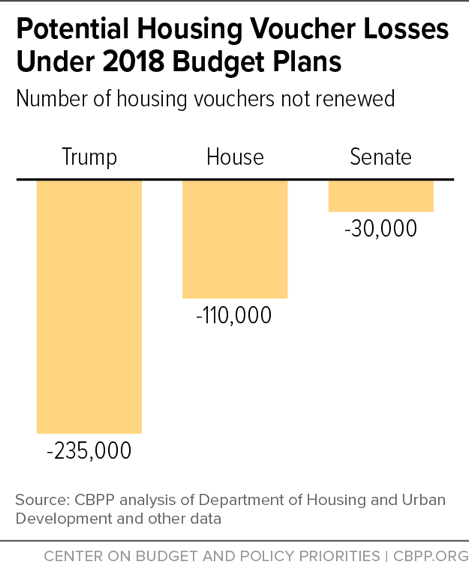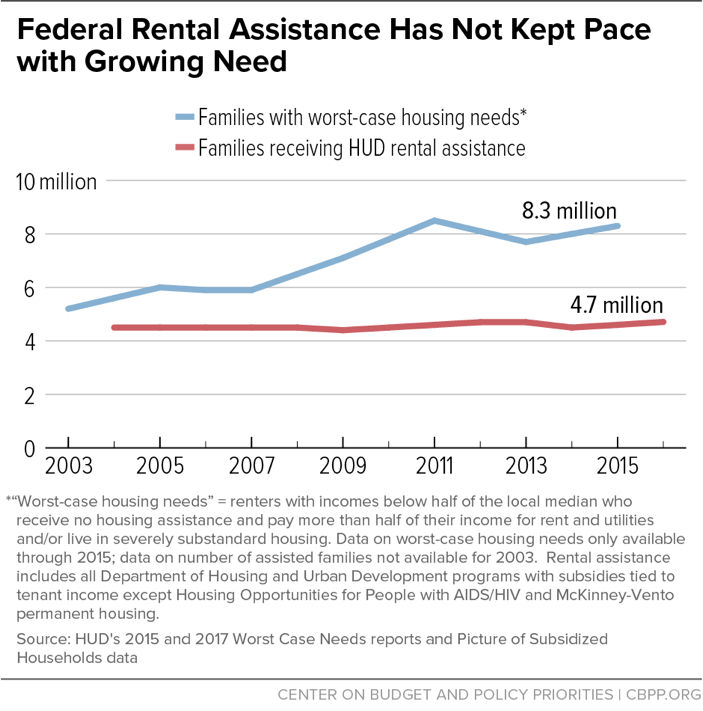Congress Should Add Funding to Prevent 2018 Housing Voucher Cuts
End Notes
[1] H.R. 3353 and S. 1655. Both the House and Senate appropriations committees passed their respective bills in July. The full House approved its bill as part of a “megabus” package in September, but the Senate has not yet voted on its bill. Congress intends to finalize 2018 funding legislation by early December.
[2] Douglas Rice, “Trump Budget Would Increase Homelessness and Hardship in Every State, End Federal Role in Community Development,” Center on Budget and Policy Priorities, May 23, 2017, https://www.cbpp.org/blog/trump-budget-would-increase-homelessness-and-hardship-in-every-state-end-federal-role-in. For more on the Budget Control Act caps, see David Reich and Chloe Cho, “Unmet Needs and the Squeeze on Appropriations,” Center on Budget and Policy Priorities, May 19, 2017, https://www.cbpp.org/research/federal-budget/unmet-needs-and-the-squeeze-on-appropriations.
[3] Both bills provide adequate renewal funding for Section 8 Project-Based Rental Assistance, Homeless Assistance Grants, Section 202 elderly housing, and Section 811 housing for people with disabilities. Both bills continue the severe underfunding of public housing, however, although the Senate bill does provide $100 million in additional funds for public housing operations, relative to 2017. The appendix table shows proposed funding levels for HUD’s major housing assistance programs.
[4] The amount of $19.64 billion is for renewals only; total voucher funding includes additional amounts for administrative expenses, tenant protection vouchers, and other program components. Consistent with our renewal eligibility estimate, we recommend at least $21.56 billion for vouchers overall. As explained below, this amount includes funds to reverse any reduction in the number of assisted households caused by the 2017 renewal funding shortfall.
[5] Will Fischer, “Research Shows Housing Vouchers Reduce Hardship and Provide Platform for Long-Term Gains Among Children,” Center on Budget and Policy Priorities, October 7, 2015, https://www.cbpp.org/research/housing/research-shows-housing-vouchers-reduce-hardship-and-provide-platform-for-long-term.
[6] Raj Chetty, Nathaniel Hendren, and Lawrence Katz, “The Effects of Exposure to Better Neighborhoods on Children: New Evidence from the Moving to Opportunity Project,” American Economic Review, 106 (4), 2016.
[7] This is $280 million less than the $19.92 billion that we estimated would be needed earlier this year (for instance, see Douglas Rice, “Trump Budget Would Increase Homelessness and Hardship in Every State, End Federal Role in Community Development,” May 23, 2017, https://www.cbpp.org/blog/trump-budget-would-increase-homelessness-and-hardship-in-every-state-end-federal-role-in). Our updated estimate is lower largely for two reasons. First, based on our review of recent HUD program data, we assume that tenant incomes will rise somewhat faster, which will reduce the amount of subsidy required in 2018. Second, we expect fewer new tenant protection and VASH vouchers to require renewal in 2018 than we had assumed earlier, based on updated information about the size and timing of these awards in 2017.
[8] In implementing the 2017 renewal funding provisions, HUD announced that the appropriation would cover 97 percent of agencies’ renewal eligibility. (For most agencies, this means that the renewal funding received for 2017 will cover only 97 percent of their actual 2016 voucher leasing and costs, adjusted for inflation and other factors.) U.S. Department of Housing and Urban Development, “Implementation of the Federal Fiscal Year (FFY) 2017 Funding Provisions for the Housing Choice Voucher Program, PIH2017-10,” June 28, 2017, https://www.hud.gov/sites/documents/PIH2017-10.PDF.
[9] These figures are a weighted combination of the CPIs for residential rents (85 percent) and household fuels and utilities (15 percent), through June 2017. Average per-voucher subsidy costs have risen at a slightly higher rate of 4.2 percent over the past 12 months.
[10] The Social Security trustees project that the 2018 Social Security Cost of Living Adjustment will be 2.2 percent; about half of voucher households are seniors or people with disabilities living on Social Security or other fixed income sources. Over the past two years, the incomes of non-elderly, non-disabled voucher households have risen 4.4 percent per year, on average, and our estimate assumes this trend will continue in 2018. Overall, we thus estimate that voucher households’ incomes will rise 3.3 percent, on average. If rents rise 3.1 percent, and voucher household incomes rise 3.3 percent, then voucher subsidies must rise 3.0 percent in 2018 to sustain current levels of affordability. (For instance, suppose a tenant contributes $300 towards a monthly rent of $900, and the resulting voucher subsidy is $600. In the next year, if the tenant’s contribution rises 3.3 percent to $310, and the rent rises 3.1 percent to $928, then the voucher subsidy rises 3 percent to $618.)
[11] Douglas Rice, “Budget Caps, Not Rent Aid, Forcing HUD Budget Cuts,” Center on Budget and Policy Priorities, October 30, 2017, https://www.cbpp.org/research/housing/budget-caps-not-rent-aid-forcing-hud-budget-cuts.
[12] Douglas Rice, “Trump Budget Would Increase Homelessness and Hardship in Every State, End Federal Role in Community Development,” Center on Budget and Policy Priorities, May 23, 2017, https://www.cbpp.org/blog/trump-budget-would-increase-homelessness-and-hardship-in-every-state-end-federal-role-in.
[13] Will Fischer, “Trump Public Housing Cuts Would Hurt Vulnerable Seniors and Families,” Center on Budget and Policy Priorities, May 25, 2017, https://www.cbpp.org/blog/trump-public-housing-cuts-would-hurt-vulnerable-seniors-and-families.
[14] Abt Associates, “Housing Choice Voucher Program Administrative Fee Study: Final Report,” August 2015, https://www.huduser.gov/publications/pdf/AdminFeeStudy_2015.pdf.
[15] See interactive graphic, “Three Out of Four Low-Income At-Risk Renters Do Not Receive Federal Rental Assistance,” Center on Budget and Policy Priorities, https://www.cbpp.org/three-out-of-four-low-income-at-risk-renters-do-not-receive-federal-rental-assistance.
[16] Department of Housing and Urban Development, “Worst Case Housing Needs: 2017 Report to Congress,” August 2017, https://www.huduser.gov/portal/sites/default/files/pdf/Worst-Case-Housing-Needs.pdf.



